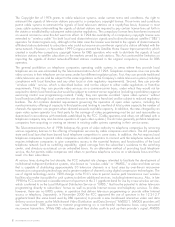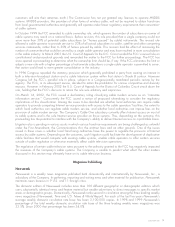Washington Post 2002 Annual Report Download - page 19
Download and view the complete annual report
Please find page 19 of the 2002 Washington Post annual report below. You can navigate through the pages in the report by either clicking on the pages listed below, or by using the keyword search tool below to find specific information within the annual report.operators. Under these restrictions, DBS operators are prohibited from distributing in a local market the signals of any
distant network-affiliated television station except in areas where the over-the-air signal of the same network’s local
affiliate is not available or where the local affiliate grants a waiver. Several lawsuits were filed beginning in 1996 in
which plaintiffs (including all four major broadcast networks and network-affiliated stations including one of the
Company’s Florida stations) alleged that certain DBS operators had not been complying with this restriction. The
plaintiffs have entered into a settlement with DBS operator DirecTV, under which it will discontinue distant-network
service to certain subscribers and alter the method by which it determines eligibility for this service. Litigation against
DBS operator EchoStar is continuing. The Satellite Home Viewer Improvement Act also provides that certain distant-
network subscribers whose service would have been discontinued as a result of this litigation will continue to have
access to distant-network service through 2004. In addition to the matters discussed above, the Company’s
television stations may also become subject to increased competition from low-power television stations, wireless
cable services, satellite master antenna systems (which can carry pay-cable and similar program material) and
prerecorded video programming. Further, the deployment of digital and other improved television technologies may
enhance the ability of some of these other video providers to compete more effectively for viewers with the local
television broadcasting stations owned by the Company.
Cable television systems operate in a highly competitive environment. In addition to competing with the direct
reception of television broadcast signals by the viewer’s own antenna, such systems (like existing television stations)
are subject to competition from various other forms of television program delivery. In particular, DBS services (which
are discussed in more detail in the preceding paragraph) have been growing rapidly and are now a significant
competitive factor. The ability of DBS operators to provide local-into-local service (as described above) has
increased competition between cable and DBS operators in markets where local-into-local service is provided. DBS
operators are not required to provide local-into-local service, and some smaller markets may not receive this service
for several years. However, in December 2000 Congress passed and the President signed legislation to provide
$1.25 billion in federal loan guarantees to help satellite carriers (and cable operators) provide local TV signals to
rural areas, and DBS operators have stated that they intend to provide local-into-local service in a greater number of
markets in the future. Local-into-local service is not yet offered in most markets in which the Company provides cable
television service, but such services could be launched by DBS operators at any time. The Company’s cable
television systems also compete with wireless cable services in several of their markets and may face additional
competition from such services in the future. Moreover, the Telecommunications Act of 1996 permits telephone
companies to own and operate cable television systems in the same areas where they provide telephone services
and thus may lead to the provision of competing program delivery services by local telephone companies.
According to figures compiled by Publishers’ Information Bureau, Inc., of the 239 magazines reported on by the
Bureau, Newsweek ranked fifth in total advertising revenues in 2002, when it received approximately 2.3% of all
advertising revenues of the magazines included in the report. The magazine industry is highly competitive both within
itself and with other advertising media which compete for audience and advertising revenue.
PostNewsweek Tech Media’s publications and trade shows compete with many other advertising vehicles and
sources of similar information.
Kaplan competes in each of its test preparation product lines with a variety of regional and national test preparation
businesses, as well as with individual tutors and in-school preparation for standardized tests. Kaplan’s Score
Education subsidiary competes with other regional and national learning centers, individual tutors and other educa-
tional businesses that target parents and students. Kaplan’s Professional Division competes with other companies
which provide alternative or similar professional training, test-preparation and consulting services. Kaplan’s Higher
Education Division competes with both facilities-based and other distance learning providers of similar educational
services, including not-for-profit colleges and universities and for-profit businesses.
The Company’s publications and television broadcasting and cable operations also compete for readers’ and
viewers’ time with various other leisure-time activities.
The future of the Company’s various business activities depends on a number of factors, including the general
strength of the economy, population growth and the level of economic activity in the particular geographic and other
markets it serves, the impact of technological innovations on entertainment, news and information dissemination
systems, overall advertising revenues, the relative efficiency of publishing and broadcasting compared to other forms
of advertising and, particularly in the case of television broadcasting and cable operations, the extent and nature of
government regulations.
2002 FORM 10-K 17
























